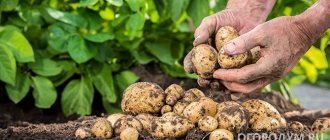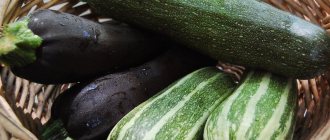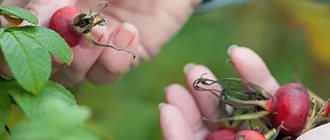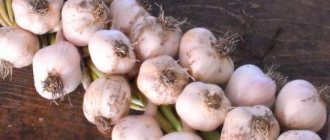There are no difficulties in how to store radishes in the cellar in winter if you follow a number of simple rules. This root vegetable, which has a large amount of vitamins and useful elements, can easily last until spring and at the same time not lose its taste and table qualities. The grown crop must be harvested on time, because unripe or overripe vegetables will not lie and the properties of the radish will deteriorate. It is extremely important not to damage vegetables during harvesting and storage.
Collection and preparation
Before you start digging up root crops, you need to make sure they are ripe. If you adhere to timely deadlines, the vegetable will reach the optimal size, which is typical for a particular variety. It is not recommended to delay the harvest time. If root vegetables become overripe, they will become tough and lose their taste.
Without any regret, you need to get rid of small root vegetables. Do not store healthy and diseased vegetables together. If the fruits are deformed, they are thrown away. Selected specimens are dug out of the soil, after which the tops are cut off.
Drooping roots are also trimmed, being careful not to damage the root. Before being sent for storage, a shaft-shaped pile is formed from the root crops and covered with a 15-20 cm layer of earth. After this, the vegetables are sorted, choosing only elastic and healthy fruits without flaws. To preserve the taste juicy and fresh, it is necessary to provide the radish with comfortable storage conditions.
When to harvest radishes in 2019
There is no need to rush into harvesting, since it ripens and fills in the fall. During this period, vitamins accumulate in it. In addition, unripe fruits quickly deteriorate. In good weather, radishes can remain in the beds until the end of October. But before the first frost it needs to be dug up. Frozen vegetables cannot be stored. Mucus appears on root crops, where pathogenic microflora is formed.
It is also recommended to ensure that the radish is not overripe. When the flower shoot appears, the radish is not eaten - inside it is hollow, loose, tasteless and dry. The degree of its maturity can be determined by the withering of the tops and the size of the root crops. Ripe vegetables should be dug up immediately and stored.
Each variety has its own technical ripeness, which must be taken into account when harvesting, as well as a recommended shelf life. All data is indicated on the seed packaging. White radish, for example, even if harvested in time, is unlikely to be preserved until winter. If absolutely all necessary conditions are met, it can last until December at most.
According to the lunar calendar, the best days for harvesting radishes in 2021 are September 8, 9, 21, 25 and 26, as well as from October 3 to October 6 and October 15 to 19. But you need to understand that the lunar calendar must be coordinated with the weather forecast, because if it suddenly rains, then you will need to forget about harvesting the radishes, and then, while waiting for a favorable day, frosts may occur and then long-term storage of root crops will become impossible.
Advice! If at the time of harvesting the radish there is abnormal heat in the region, then it is recommended to postpone the process until the air temperature drops, otherwise the shelf life of the root crops will be significantly reduced, and they will not last until winter.
When to harvest radishes in the middle zone
In the middle zone and Moscow region, it is recommended to harvest the crop from late October to early November. At this time the weather is still good, allowing it to ripen.
When to harvest radishes in the Urals
Radishes are harvested earlier in the Urals because the region has an unpredictable climate. It is advisable to do this in September or early October, before the rains begin. Agronomists recommend sowing varieties that have a short growing season, so that by this time the radish has time to ripen.
When to dig radishes in Siberia
In cold Siberia, crops from ridges and fields must be removed before the beginning of October, depending on the weather. Some varieties may not have time to reach ripeness, will be tasteless, crumbly, and will quickly deteriorate. You should carefully review the technical characteristics of the vegetable and adaptation to a specific region so as not to be disappointed in the choice when harvesting.
At what temperature should it be stored and for how long?
The scheme is as follows:
- refrigerator - +2 °C, from 1 to 1.5 months;
- freezer - -15 °C, up to a year;
- balcony - 0 °C, up to 8 months;
- cellar or basement - 0 °C, 8-10 months.
It is important to observe the specified temperatures. Tested by gardeners and farmers.
Preparation for storage
Root crops harvested in time must be prepared for storage:
- They start by sorting through the crop, putting aside small and slightly damaged radishes.
- For final drying, place the collected product in a room where it is well ventilated and not exposed to sunlight.
Cellars or basements also need preparation for storing fresh vegetables:
- To do this, clean the premises of debris, disinfect wooden surfaces with special solutions, and whitewash them with copper sulfate diluted with lime in a ratio of 1:20.
- It is necessary to thoroughly dry the basement before planting the root crops.
- Do not forget about sealing cracks that can become passages for rodents.
We recommend reading: Honey mushrooms have oxidized and turned black
All work must be completed 2 weeks before the radish harvest is planted.
Storing for the winter at home
People who grow root vegetables want to enjoy them for as long as possible. To please yourself and your loved ones with fresh vegetables, they make preparations for the winter. Thus, on vitamin-free days, you can pamper your body with fresh radish and replenish your supply of vitamins. At home, it is possible to ensure the storage of vegetables.
Recommendations for choosing a location
It is very important to choose the right room in which the vegetable will be stored. Naturally, if summer residents stay in their country house for the winter, then there will be no problems - they will keep everything in the cellar. But even in a private apartment, you can choose the best option. For example, they manage to keep radishes fresh for up to 7 months in the garage, in the refrigerator or on the balcony.
Cellar
The optimal place to store radishes is the basement of a country house. There the humidity level is up to 85 percent, the temperature is about 2 degrees in winter.
Fruits collected from the garden are placed in small boxes made of wooden strips. Each layer is sprinkled with sand on top - this will preserve it for the longest time. But it is also possible not to sprinkle it, but to use multi-tiered containers. The container must have holes for ventilation. You cannot store apples and pears near radishes - the products will oxidize. But you can and even should put it together with potatoes and carrots - they drive away insects.
Garage
Storage in a garage is no different from storage in a basement. The container used is the same. It is important to observe temperature indicators - not to exceed 3 degrees.
Apartment
The apartment has several storage options.
Balcony
A balcony is a solution for those summer residents who prefer to spend the winter in their apartment. If the balcony is large, then put the radish in wooden boxes, sprinkle with a layer of sand 2-3 centimeters. If the area is minimal, then it is better to pack the root vegetables in film bags that do not allow air to pass through.
Fridge
In the refrigerator, radishes can stay on the bottom shelf until early spring. It is packed in bags or bags so that it does not lose moisture. The temperature on the bottom shelf is optimal, no additional actions are required. But the problem is that other products are also stored in the refrigerator, so there will be little space left there.
See also
How and for how long you can store raspberries at home, the best ways
How to properly store radishes for the winter
There are various ways to store radishes at home. Each of them has its own characteristics that must be taken into account before choosing.
Cellar storage
Any variety of this vegetable feels best in the basement or cellar. In such rooms the temperature is no higher than +3 °C with a humidity of 85%. Before placing root crops for winter storage, they are carefully prepared. The room itself should not be infested with parasites and fungi. If insects live in it, get rid of them.
See also
Review of the best daikon varieties for open ground and winter storageRead
Boxes with holes filled with radishes are carried into the basement. Each layer is sprinkled with slightly damp sand. In the same way, radishes can be stored on racks. To maintain comfortable conditions, the sand is periodically moistened, and rotten and damaged specimens are disposed of. If you don't do this, healthy vegetables that were nearby may spoil.
Wooden barrels are also suitable for storing radishes. In addition to containers, they choose neighbors - vegetables and fruits that will not have a negative impact on storage. Carrots and potatoes are the best company. It is not advisable to place apples or pears nearby, as they can accelerate the germination of radishes. In addition, vegetables from such a neighborhood begin to absorb foreign odors.
In the apartment in the refrigerator and freezer
How to store crops if the house is not equipped with a cellar and basement? There is only one answer - a refrigerator. To do this, all vegetables are placed in polyethylene bags with holes made so that they can breathe freely. Containers are placed on the lower shelves.
If the refrigerator has special drawers for vegetables, there is no need to put radishes in bags. In this case, you need to keep in mind that vegetables cannot be stored in this form for a long time. It is recommended to eat root vegetables as soon as possible. This option is suitable if the vegetable needs to be on hand in the near future.
Experienced gardeners do not recommend using the freezer for this purpose. Freezing will make the vegetable tasteless and soft. It can be frozen only in one case - the treatment of colds. Grated root vegetables are packaged in bags and stored in the freezer. If necessary, take out just one and use it immediately.
It is better to store vegetables on a shelf in the refrigerator rather than freeze them. At the same time, they are checked for the presence of rot or mold. Over time, they become soft and unfit for consumption. Such instances should be disposed of.
On the balcony
If a person does not have a country house, storage conditions can be organized on the balcony. They will feel best in wooden boxes sprinkled with sand on top. If the frosts are very severe, containers filled with vegetables are covered with cotton blankets. This option is suitable for Margelan, black and green radishes.
The balcony or loggia for storage must be glazed. This is important because optimal temperature is a key feature in this matter. Glass prevents sediment from settling, because moisture promotes the development of rot and mold. The temperature on the balcony should never be below 0 °C.
Conservation
In addition to storing fresh vegetables, you can roll them in jars and thus get a completely different taste. Preserving your crops for the winter is a great idea. There are a lot of recipes for creating blanks. Most Popular:
- Pickling. Vegetables are peeled and washed thoroughly, then cut into small pieces and sprinkled with salt. Remove excess moisture by placing everything in a colander and rinsing again. Divide the required amount into jars, sterilizing them first. Prepare a marinade based on water, vinegar, salt and sugar. Remove the boiled liquid from the heat and let cool. Then pour into jars and close with plastic lids.
- Pickled vegetables. Peeled root vegetables are crushed using a fine grater and garlic and salt are added to taste. The mass is placed in jars, compacting it tightly. Store in a dark and cool place. The product is ready for use after 2 weeks, by which time the radish will have completely fermented.
- Vegetable salads. The radish, along with other vegetables, is chopped and sealed in jars. Other ingredients include dill, parsley, celery, carrots, white cabbage and garlic. Assorted vegetables are also packed tightly into jars, adding vinegar, salt and sugar. Under covered lids, containers with vegetables are sterilized in water.
See also
Planting, growing and caring for daikon, when to plant in open groundRead
Regardless of the chosen option for preparing radishes, store the jars in a dark and cool place.
Main varieties
The method and period of storage depends on the variety.
Daikon
Daikon is a white radish. This variety is considered the most popular due to its low maintenance requirements and excellent taste characteristics. Just one hundred grams of the product contains the daily requirement of vitamin C. Therefore, you can easily replenish it with the help of one vegetable.
Black
Black radish is called monastic radish. It is also quite good in taste, aroma, and can be stored for quite a long time.
Green
Green radish has a pleasant taste, but its pulp, unlike daikon and black, is softer and juicier.
Chinese
Chinese radishes come in a variety of colors. You can grow lilac, red, pink or green in your own garden, and no difficulties will arise. Chinese has a pleasant structure, density, and great juiciness.
Features of storage of different varieties
How to preserve a vegetable so that it does not lose its taste? Features regarding the preservation of root crops depend on their type. It is better to keep Margelan and black in the refrigerator, after placing it in a bag. This method has the advantage that the percentage of air humidity inside the bag increases, contributing to an increase in carbon dioxide. Due to this, the shelf life of green and black radishes becomes even longer.
Summer
The first to be stored are summer varieties, including pink and red Chinese, Viennese yellow and long white. The remaining soil is removed from each root crop, cutting off the roots and tops. If you leave them, the radish will dry out in a few days. It is better not to count on long-term storage of summer varieties, since they are not intended for this. They begin to deteriorate after 5-6 days, so the storage period does not exceed a week.
To extend shelf life, radishes are placed in the refrigerator. Before doing this, perform the following procedure:
- select the most suitable specimens;
- remove parts with flaws;
- placed in a polyethylene bag.
Black radishes should only be stored in bags with holes to allow fresh air to reach the collected vegetables. Temperature fluctuations should not fall outside the range of +1 °C to -2 °C. Relative humidity also plays an important role. Comfortable conditions - 85-90%.
Following these simple rules will help increase the shelf life to 1 month.
Autumn
Winter storage is a long period that some varieties of radish may not withstand. Daikon is an autumn plant and, if certain rules are followed, will last until early spring. For this purpose, use a basement or cellar. But before laying the vegetables, the room is prepared.
Winter
Winter varieties of radish that have good shelf life are most suitable for long-term storage. To extend the deadlines, the harvest is harvested almost at the last moment. At the same time, frost must not be allowed to occur. The suitable period is late September to mid-October.
The duration of storage depends on many factors, including the type of vegetable, room, preparation and harvest time. If you don’t take into account at least one point, your work will not bring the desired results. Therefore, you must follow all rules and recommendations. In addition, they have been tested over the years by experienced farmers, agronomists and simple gardeners.
Classification of varieties
There are several varieties of radish. They differ not only in taste, but also in storage methods, and in what temperatures must be maintained.
Early
Early varieties ripen first. But, alas, by the time they are stored, such fruits are already unusable. Therefore, summer residents do not store radishes of early ripeness. It is eaten immediately, you can preserve it, or close the salad.
See also
10 ways to quickly and easily fold a T-shirt without wrinkles
Mid-season
Mid-season varieties have high shelf life, so some of them are chosen for storage in the cold season. The most popular varieties:
- Healer;
- Sultan;
- Margelanskaya.
Late ripening
Among the radish varieties that ripen late, those with the best taste characteristics are Red Giant and Gaivoronskaya.











